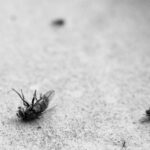Flies, those buzzing, bothersome insects, are an unwelcome guest in any home. From the common house fly to fruit flies, these pests can quickly turn a peaceful environment into an irritating one. In the quest for a quick fix, many homeowners reach for readily available household products, and Febreze, a well-known odor eliminator, often comes to mind. But can Febreze actually kill flies? Let’s delve into the facts and explore effective fly control methods.
Understanding Febreze and Its Purpose
Febreze is primarily designed to eliminate odors, not pests. Its main mechanism involves trapping and neutralizing odor molecules, leaving behind a fresh scent. The key ingredients in Febreze are cyclodextrins, which are ring-shaped sugar molecules that trap and bind odor molecules. While this process is effective for freshening fabrics and air, it’s fundamentally different from how insecticides work. Insecticides target the nervous system or biological processes of insects to kill them.
Does Febreze Have Insecticidal Properties?
The short answer is no, Febreze is not designed to kill flies or any insects. Its formula lacks the active ingredients found in insecticides that are specifically toxic to flies. While spraying Febreze directly at a fly might temporarily stun or disorient it due to the force of the spray or the wetness of the liquid, this is not a lethal effect. The fly will likely recover quickly once the initial shock wears off.
:max_bytes(150000):strip_icc():format(webp)/fruit-flies-lead-7367399-0923-317899a6e101404a878b373386a14988.jpg)
Febreze’s action is purely physical and olfactory, not toxicological. It doesn’t contain neurotoxins or chemicals that disrupt the biological functions of flies. Therefore, relying on Febreze as a fly killer is ineffective and misinterprets the product’s intended use.
Why People Might Think Febreze Works (And Why It Doesn’t)
The confusion might arise from observing flies being temporarily affected by the spray. When you spray any liquid at a fly, especially with some force, it can be momentarily knocked off balance or have its wings dampened. This can give the illusion that Febreze is working. Furthermore, the strong scent of Febreze might temporarily deter flies from the immediate area, as flies are sensitive to strong odors. However, this is a repellent effect, not a killing effect, and it’s not a reliable long-term solution.
:max_bytes(150000):strip_icc():format(webp)/pesticide-969383538-584a39825f9b58a8cd7a1e44.jpg)
In contrast, dedicated insecticides contain chemicals specifically designed to kill insects. These chemicals, often pyrethrins or pyrethroids in household sprays, disrupt the fly’s nervous system, leading to paralysis and death. Febreze simply lacks these crucial insect-killing ingredients.
Effective Ways to Get Rid of Flies
Instead of relying on ineffective methods like Febreze, focus on proven strategies to control and eliminate flies:
Prevention is Key
Similar to fruit flies, preventing house flies and other fly species from entering your home is the most effective first step.
- Seal Entry Points: Flies can enter through small cracks and openings. Seal gaps around windows, doors, and foundations. Ensure window screens are in good repair and properly fitted.
- Maintain Cleanliness: Flies are attracted to decaying organic matter. Regularly clean your kitchen, especially areas where food debris accumulates. Wipe up spills promptly and keep garbage cans clean and covered.
- Proper Food Storage: Store fruits and vegetables properly. Overripe produce is a major attractant, especially for fruit flies. Refrigerate ripe produce or store it in sealed containers.
- Manage Garbage: Empty garbage cans frequently, especially kitchen bins. Use bins with tight-fitting lids to minimize odors that attract flies.
- Clean Drains: Drains can be breeding grounds for flies. Regularly clean drains with drain cleaner or a mixture of baking soda and vinegar.
Active Fly Control Methods
When flies are already present, employ these methods for effective removal:
- Fly Swatters: A classic and direct method for eliminating individual flies.
- Fly Paper and Sticky Traps: These traps attract flies to a sticky surface where they become trapped and die. They are effective and non-toxic.
- Fly Traps (Bait Traps): These traps use bait to lure flies into a container from which they cannot escape. You can purchase commercial traps or create DIY versions using sugar water or vinegar.
- Insecticide Sprays: For more significant infestations, insecticide sprays specifically designed for flies can be used. Use these products cautiously, following label instructions, and ensure good ventilation. Opt for sprays containing pyrethrins or pyrethroids for effective fly control.
- Professional Pest Control: For persistent or large-scale fly problems, consider consulting a professional pest control service. They can identify the fly species, locate breeding sites, and implement targeted and effective control measures.
Conclusion: Febreze is Not a Fly Killer
While Febreze is excellent for freshening your home and eliminating odors, it is not an effective solution for killing flies. Its mechanism of action is simply not designed for pest control. To effectively manage flies, focus on preventative measures like cleanliness and sealing entry points, and utilize proven fly control methods such as traps, swatting, and appropriate insecticides when necessary. Understanding the limitations of products like Febreze and focusing on targeted solutions will lead to a fly-free and more comfortable home.
